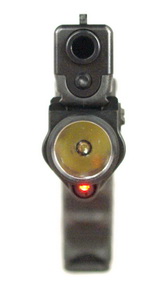Streamlight’s TLR weapon lights have long been popular handgun accessories. Indeed, a tactical gun should always be carried with a light source, and strapping a flashlight right to the gun makes sure you’ll never be armed but unable to positively identify a threat due to darkness.
I’ve raved before about the utility of laser sights, so I thought when manufacturers started combining lights with lasers it would be a synergistic win.
 The problem is that Streamlight and its competitors all went about this by tacking laser sights onto the bottom of their weapon lights. This is less than ideal because the light is already mounted under the barrel, so the laser ends up almost 2.5 inches from the bore of the gun it’s supposed to sight.
The problem is that Streamlight and its competitors all went about this by tacking laser sights onto the bottom of their weapon lights. This is less than ideal because the light is already mounted under the barrel, so the laser ends up almost 2.5 inches from the bore of the gun it’s supposed to sight.

Granted, if you follow my instructions to always sight a laser parallel to the bore this just means that the bullet will hit 2.5″ above the laser at point-blank range, and that the Point-of-Impact (POI) will gradually converge on the laser before crossing below it. But I’m afraid many people are still tempted to zero their lasers for a specific range — say, 21 feet for a defensive handgun — and in that case the distance between bore and laser can cause very bad POI shifts for any other distance.
The following chart shows the Point of Impact relative to the laser for a bullet fired from the gun shown above. If the laser is sighted parallel to the bore then POI is within 2.5″ of the laser out to 50 yards. However if the laser was zeroed to match POI at 7 yards you can see that it is way off for longer ranges. For example, on a 30-yard target the bullet will already strike 10 inches below the laser indicator, and it goes rapidly downhill from there!

Many of the manufacturers who do this do so for ease of production rather than any decent reason. Many of these companies offer just the light for sale, and a model with both a light and a laser. In the interest of parts commonality, they simply take the existing model (light only) and alter the casing to incorporate a place for which to insert a laser module. I applaud Veridian Lasers for taking the opposite approach; building a sturdy laser, then allowing a light to be installed underneath as an optional add on. The only reason why I have not bought one yet was due to the fact that they only make green lasers, which have dramatically reduced battery life due to the higher energy of the wavelength used.
I’ve been biding my time waiting for a good green tactical laser to reach my price/performance point. Given the FDA restrictions on energy output of any consumer laser (5mW) the advantages of our photosensitivity to green light make them many times more visible than red lasers. The green laser technology is still maturing; in the limit the cost and power consumption compared with red lasers should be negligible.